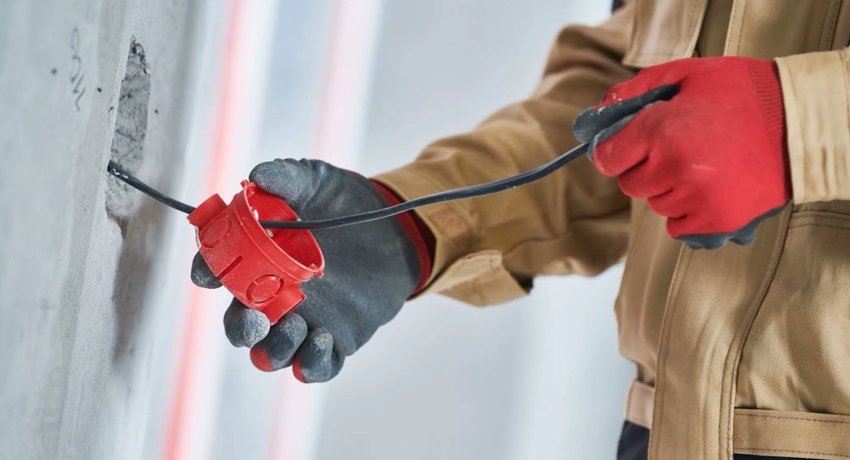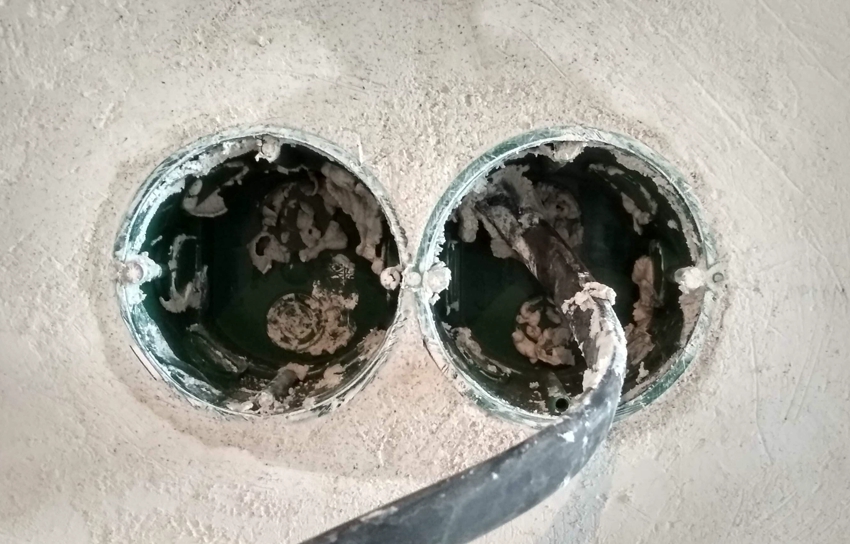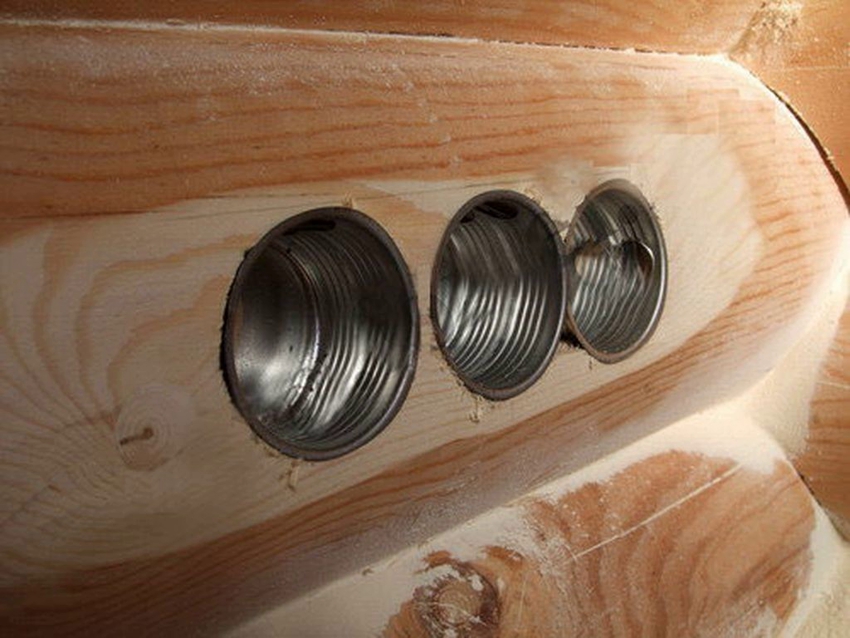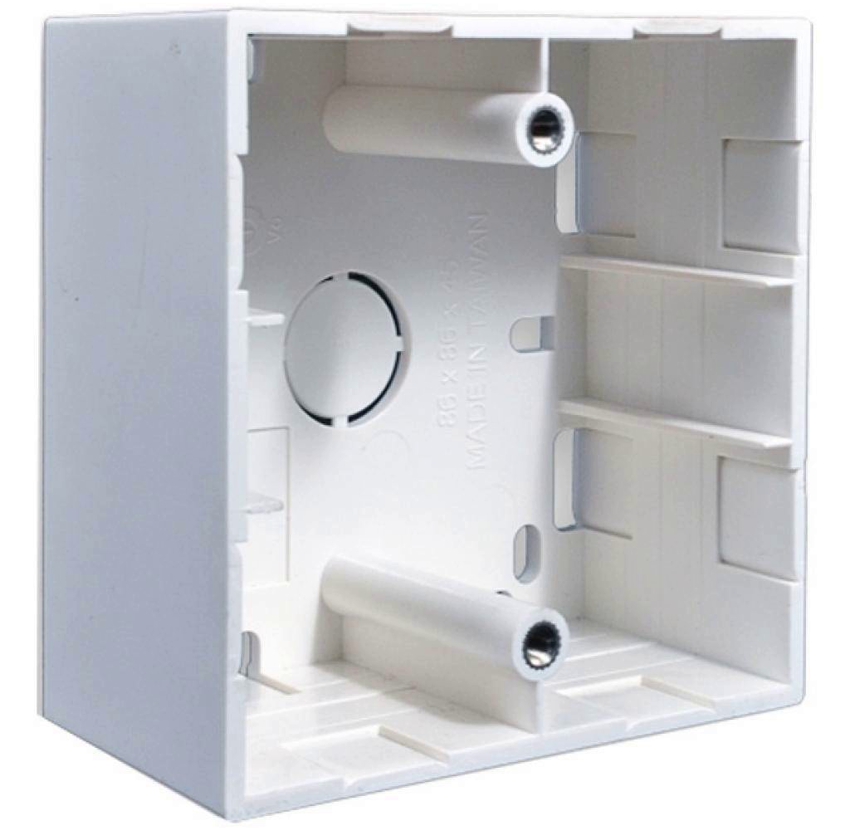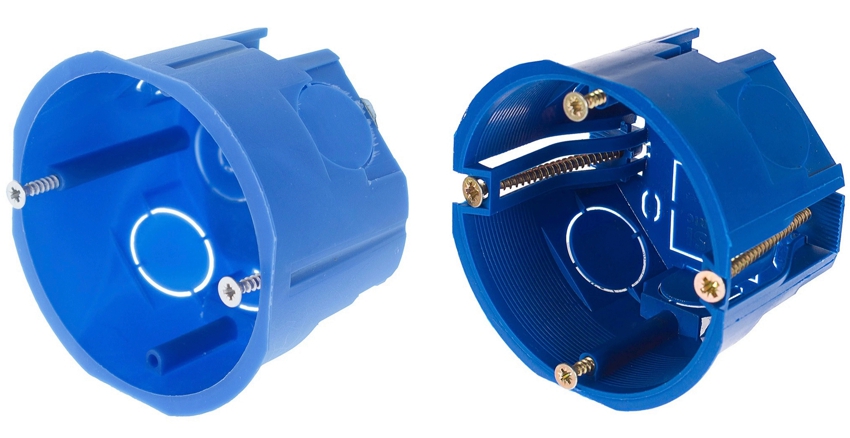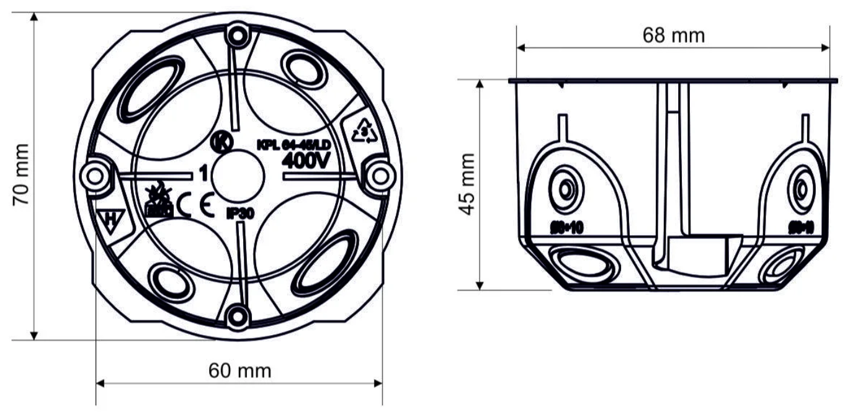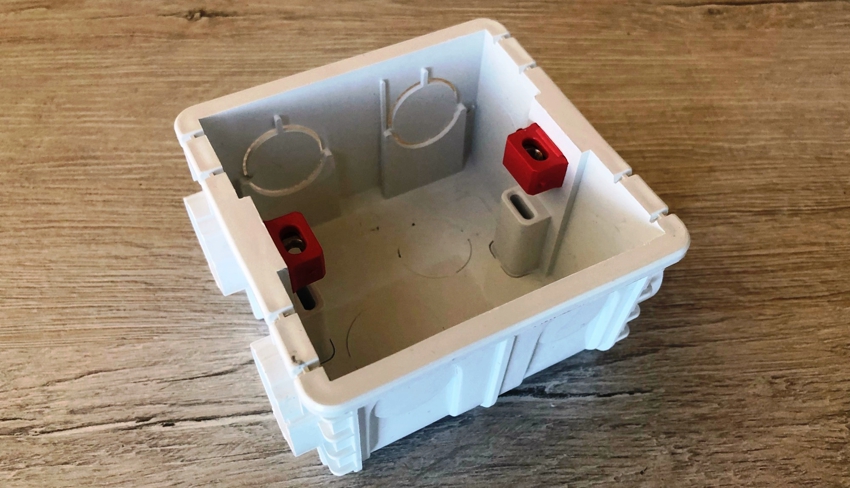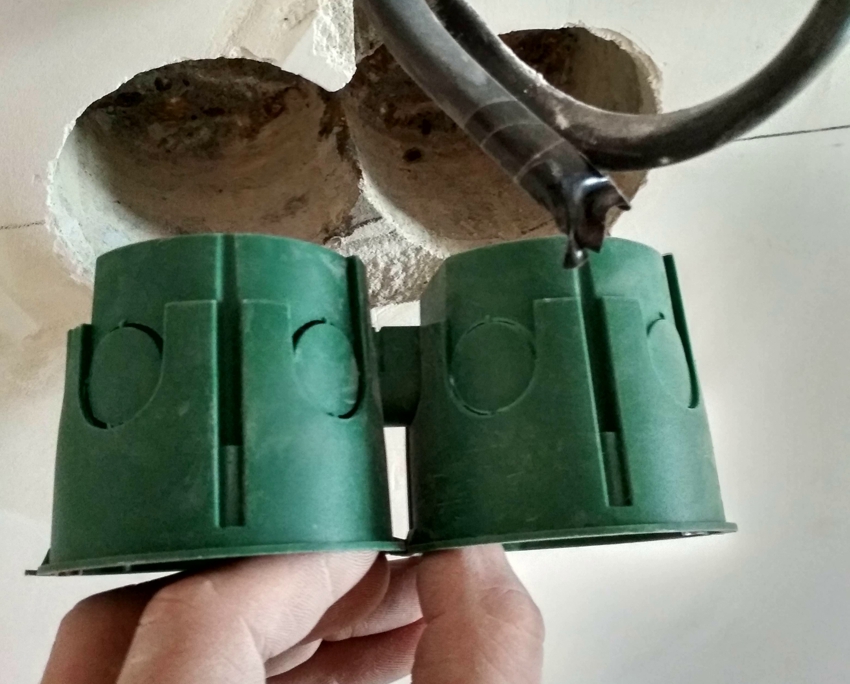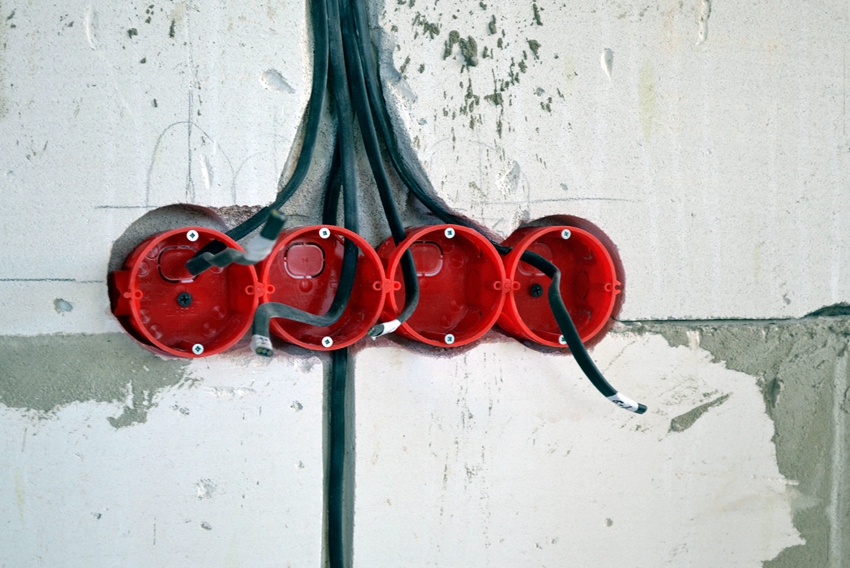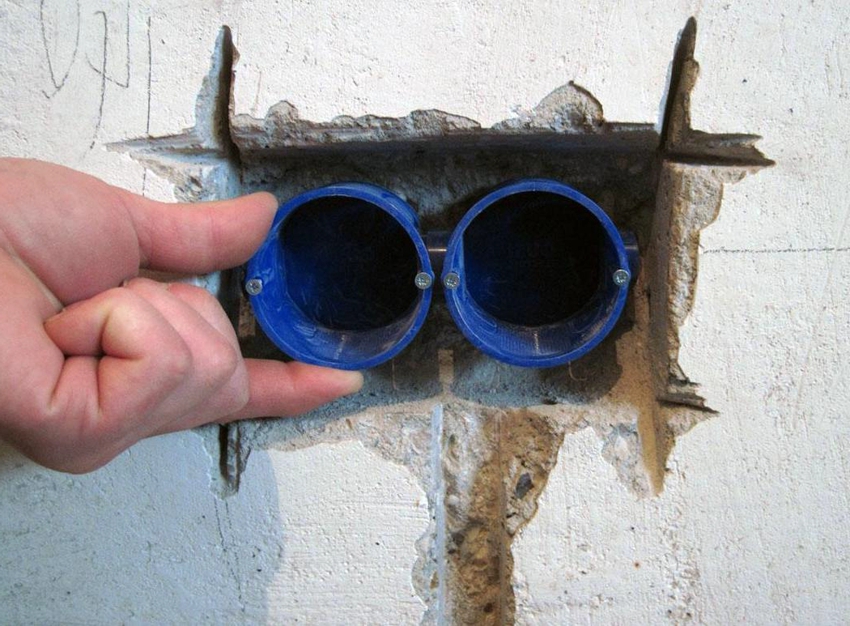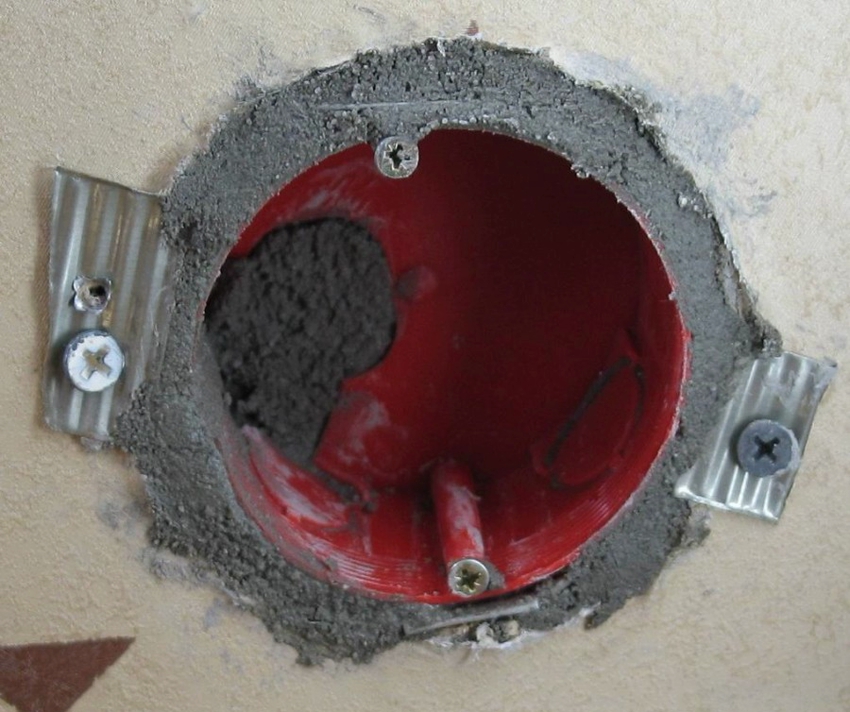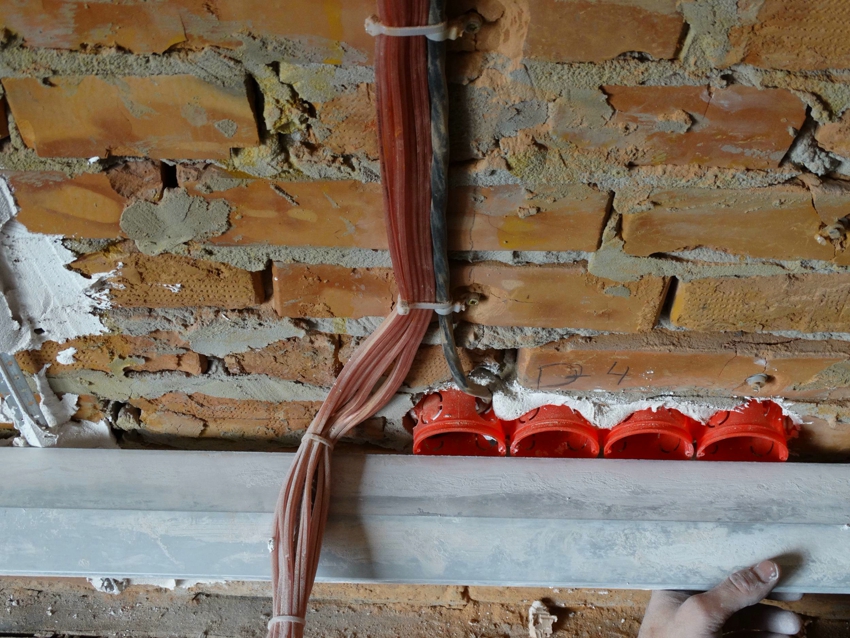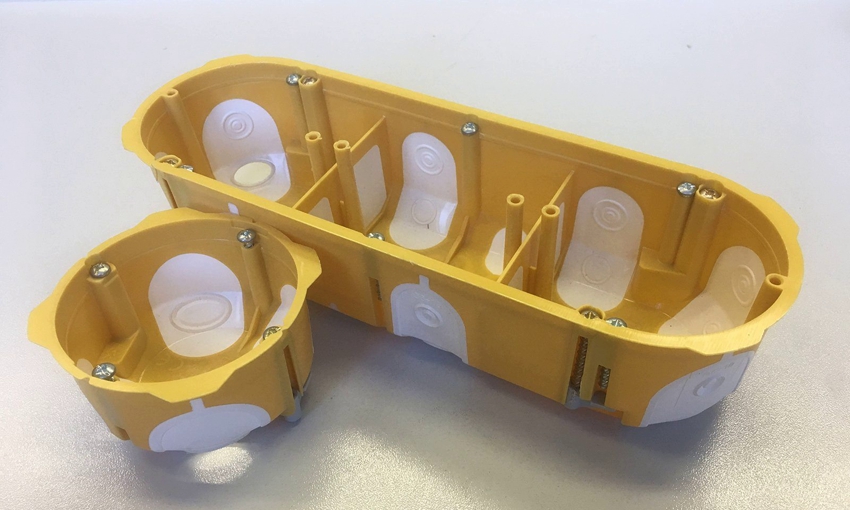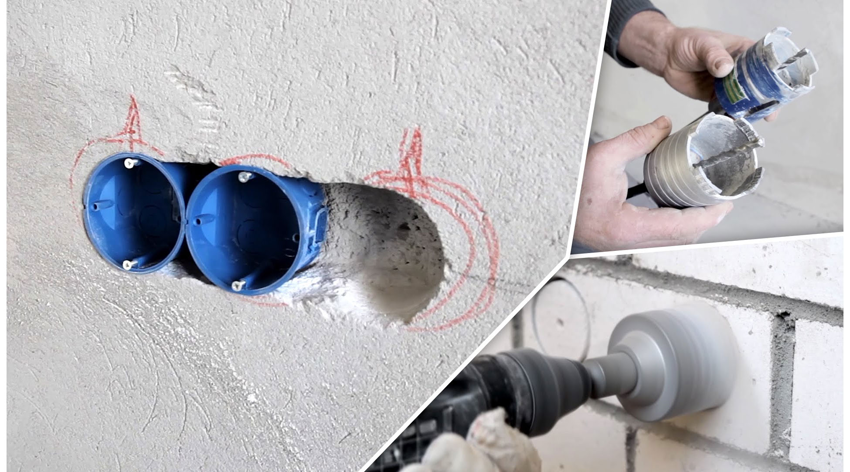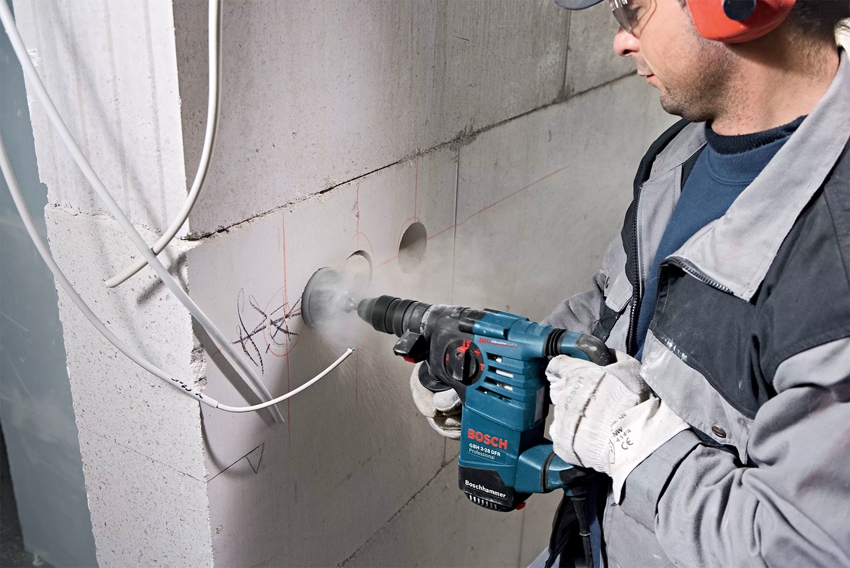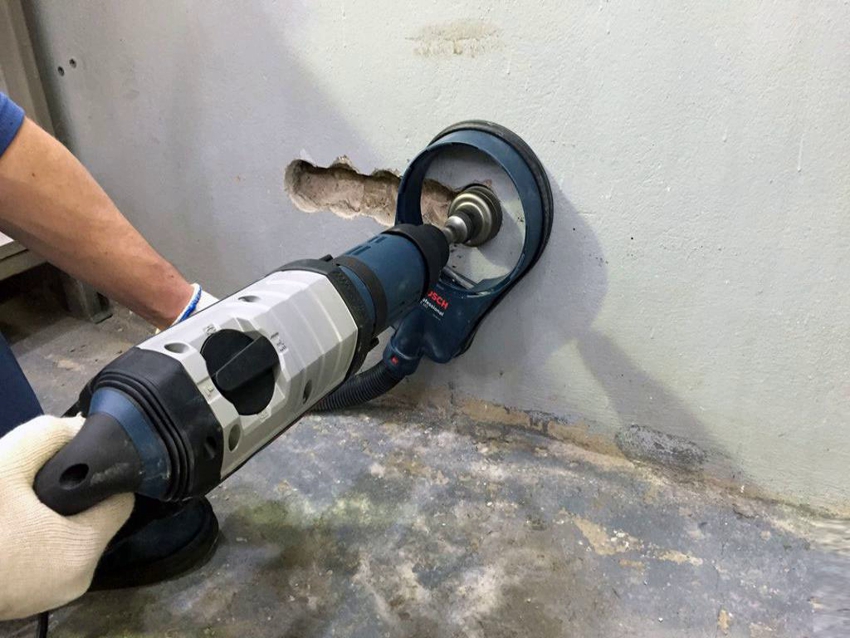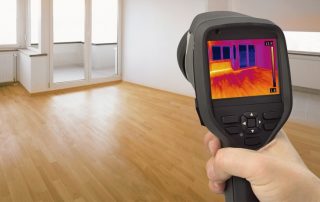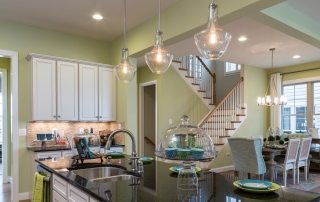For the installation and safe operation of wiring equipment, a socket box is used: the diameter of this element, its depth and other parameters depend on the type of surface with which to work. This article will help you understand the existing types of mounting boxes and learn how to select products of optimal sizes for walls made of concrete, drywall and other materials.
Content [Hide]
- 1 General information about mounting boxes: sizes and types of socket boxes
- 2 Varieties of boxes for sockets by installation method
- 2.1 Solid walls: the dimensions of the socket boxes for concrete and other materials
- 2.2 Why is the installation of deep sockets in concrete carried out?
- 2.3 Drywall sockets: product sizes for thin partitions
- 2.4 Installation boxes for mounting skirting sockets
- 2.5 Composite structures and triple sockets in one socket
- 3 How to choose the right crown for the socket
General information about mounting boxes: sizes and types of socket boxes
A junction box or glass for an outlet is a special box that is used when organizing electrical wiring in a room. It is required for the safe installation of such system components as:
- plug-in sockets;
- switches;
- regulators and control panels for adjusting electrical appliances;
- terminal blocks;
- dimmers that control light intensity.
Provided that the technology is followed and the correct size is selected, the socket boxes in the walls will protect users from electric shock.
What are the socket boxes: types and classification of products
For the manufacture of glasses for sockets, plastic is used, as well as metal and wood. Each material has its own characteristics. Wooden boxes are only suitable for surface wiring, so they are not as popular as plastic ones. Metal products are practically not used, since they often provoke a short circuit. The scope of their application extends to wooden houses.
The best option is plastic. For the manufacture of such glasses, non-combustible material is used. Manufacturers of plastic products adjust the dimensions of the socket boxes to fit drywall and wall structures made of wood, concrete and other materials.
Glasses made of plastic are suitable for mounting sockets on surfaces with various types of finishes:
- Fiberboard;
- plywood;
- Chipboard;
- lining.
Important! Regardless of the type of room, wiring must be installed in accordance with established rules and regulations. Thanks to this, the connection and subsequent operation of electrical devices will be convenient and safe.
In terms of shape and type of construction, mounting boxes are:
- Round - universal products, the most popular.
- Square - they are more spacious.
- Oval - designed for installation of 2 sockets or "socket-switch" design.
- Composite - blocks that allow you to combine several socket outlets in one design (from 2 pcs.).
Despite the differences in configuration, all designs look like a glass. Alabaster or plaster of paris is used to fix the products in the wall.
On sale there are models with and without additional fasteners. The choice depends on the surface material. Concrete is a dense and durable material. Products are securely fixed in it without additional fasteners. It is enough just to choose the appropriate size of the crown for the socket in concrete, make a hole and install the product in accordance with the technology. If the walls in the room are soft, hollow, it is better to take boxes with fastening strips. Due to them, the socket will be securely fixed in the hole.
Socket boxes differ from each other in design and color scheme. As a rule, this factor is important for overhead products that are installed in the skirting board. After all, they are part of the interior. However, the external design does not affect their functionality in any way.
What parameters does the socket have: diameter and overall dimensions
Plastic cups are most commonly made from polyamide, polyvinyl chloride (PVC), or polypropylene. The size of the socket for the outlet, or rather its parameters, depend on the shape of the structure.
For round products, the main parameters are diameter and depth. Sizing data is usually indicated on the glasses themselves. The diameter is denoted by the letter "D", and both external and internal indicators are measured:
- Outer - the maximum diameter that determines the size of the outer part of the socket itself. It serves as a guideline when choosing the diameter of the crown for the socket.
- Internal - diameter that determines the maximum possible dimensions of the device that can be installed in the box.
The most demanded are socket boxes with such a diameter: 75, 70, 68, 65, 64 and 60 mm.
Important! In order to properly and reliably install a switch or socket, you need to select these mechanisms so that their size matches the inner diameter of the mounting box.
The depth of the socket is indicated by the letter "H". As with the diameter, the glass has two indicators:
- Mounting Depth - shows the depth of the hole required for normal installation of the socket in the wall.
- Internal Depth - defines the depth of the box from the inside. This space is used for mounting the socket. There is also a supply of wires.
Most often this parameter is 62, 60, 45, 42 or 40 mm. There are also deeper glasses up to 80 mm in size. This option is used if there are no junction boxes in the wiring. The increased depth allows the installation of terminal blocks.
If it is planned to install oval boxes or composite blocks, the center-to-center or fixing distance is also taken into account. This parameter shows at what distance the centers of the axes (holes) are from each other. This allows you to achieve an optimal distance between the outlets. According to the standard, it is 71 mm.However, this figure can vary in both directions, since manufacturers sometimes deviate from generally accepted parameters.
For square boxes, the dimensions are determined by the following parameters:
- Height.
- Width.
- Depth.
- Center-to-center distance.
Let's take a glass with dimensions 68x68x43 as an example. The dimensions of the socket box 68x68 indicate that both the width and the height of the square product are 68 mm. The depth of the back box is 43 mm.
Standard socket sizes and variations from different manufacturers
Standard size products have a diameter of 68 mm. Their depth is 45 mm. Taking into account these parameters, the markings for the installation of glasses are applied so that strictly 71 mm is obtained between the fixing centers. In accordance with this, the dimensions of the crown for the socket are also selected.
Note! Standard dimensions refer to the external dimensions of the product. The inner section of such boxes is 65 mm and their depth is 40 mm.
Glass sizes may vary from manufacturer to manufacturer. To avoid inconsistencies, it is advisable to use junction boxes and electrics from the same brand.
In Legrand flush mounts, the outer edge can reach 70 mm, and the depth is 65 mm. These products are considered giants. Although the manufacturer offers several options at once, including boxes whose diameter is 68 mm, and the depth can be 60 or 40 mm.
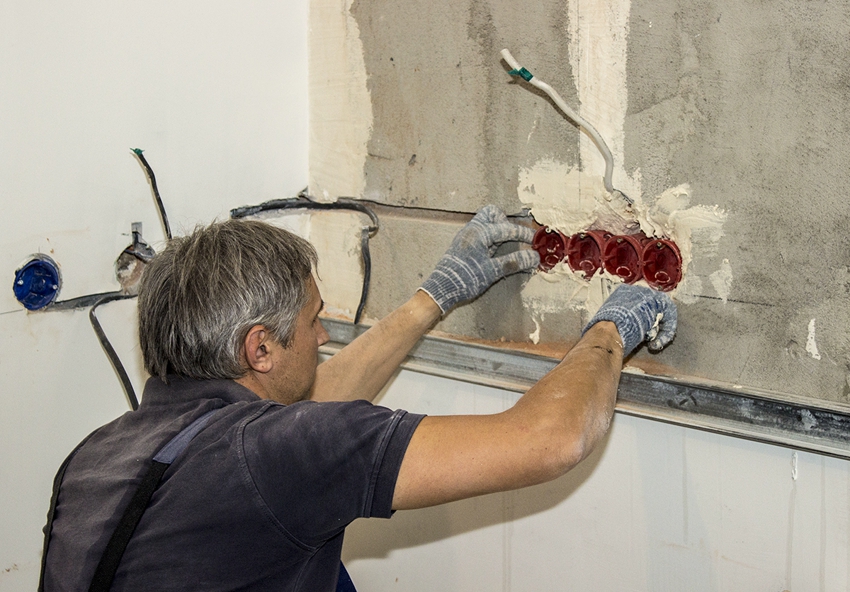
Some manufacturers deviate from the generally accepted sizes and produce glasses of non-standard dimensions
Glasses from the domestic manufacturer Hegel also have a depth of 60 mm with a standard diameter of 68. These boxes are designed for installing dimmers with complex designs and switches.
Schneider's socket boxes have a clearly marked standard - 65x45 mm. These products are manufactured in Russia and are in high demand among buyers.
As for the depth of commercially available products, it varies between 40-60 mm. This parameter is selected taking into account the size of the fittings that will be installed. In stores, you can also find in-depth options - 75-80 mm.
There are also smaller glasses. Their depth does not exceed 25 mm. These boxes are used when it is required to organize two power points in a thin partition and install sockets on both sides of the wall. This installation option will not allow the use of standard size elements, since they will not completely enter the partition and will protrude above its plane.
Square products also have their own standard. Their size is 70x70 mm. As rare exceptions, you can find square glasses measuring 60x60 mm.
Varieties of boxes for sockets by installation method
When choosing a back box, several factors are taken into account. You should pay attention not only to the material of the product, its shape and type of construction, which can be single, double or triple (there are even in-line ones). The type of installation (vertical or horizontal) is also important, as well as the material of the wall where the installation will be carried out.
Glasses can be installed on the following types of surfaces:
- full-bodied walls;
- plasterboard partitions;
- skirting boards.
Important!The dimensions of the crown under the socket, as well as the size of the glass itself, are selected taking into account the type of surface. Each material has its own requirements for the parameters of the system, so the technology and set of tools may vary.
Solid walls: the dimensions of the socket boxes for concrete and other materials
If it is planned to install communications in solid walls, experts recommend using the brickwork method.This method is applicable to rooms where partitions are made of aerated concrete, brick, concrete, stone and other materials with a similar structure.
Since solid walls are quite thick, there are no strict restrictions on the depth of the concrete flanges, their shape and structural structure. However, there is a single standard for the diameter - 68 mm. Moreover, this indicator is not a requirement of the material itself, as such.
Related article:
Motion sensors to turn on lights: a surefire way to save energy
Description of the device. Varieties of devices according to different criteria. Sensor installation algorithm. Popular models. Lamp with DD.
Concrete wall panels have generally accepted parameters. They are cast together with recesses for mounting sockets and channels where the power cable is laid. There are clear building codes for making concrete wall panels, and the size of the socket is already a by-product of these rules. For solid walls, boxes with a depth of 41-45 mm are usually taken. This is quite enough to properly install any kind of sockets and switches.
Excluding load-bearing walls, the thickness of the partitions in the room is at least 8-10 cm. Power points are usually designed at the same level. Thus, the sockets will be located on both sides of the wall. In addition, they will be powered by a single power cable. This means that the total depth of both boxes should not exceed 9 cm, that is, no more than 45 mm for each.
Why is the installation of deep sockets in concrete carried out?
Deep glasses are mounted in load-bearing walls. The thickness of these partitions allows installing not only standard products, but also boxes with increased parameters. Installation is carried out using the same crown for 68 mm socket boxes, since the diameter of the glasses remains the same.
Deep mounting boxes are used for various purposes. Firstly, they are suitable for installing sockets under a TV cable or local Ethernet network. In this case, the bending radius of the inner wire must be large enough. Conventional glasses do not provide such conditions, therefore, the landing depth should be increased to 61 mm.
Secondly, the box with an elongated body allows the installation of volumetric elements. These include sockets with a custom module or switches. All filling will fit easily inside thanks to this extra 15-20 mm.
Third, increased depth is required for dual purpose glasses. These products are called bunk. Thanks to them, the finish looks more aesthetically pleasing, and manufacturers can save on the amount of material.
Note! Bunk glasses are suitable not only for sockets, but also for switches.
Drywall sockets: product sizes for thin partitions
Conventional solid wall glasses are not suitable for mounting outlets in drywall. For these partitions, special designs with a special structure are provided. To designate the size of the boxes, the outer diameter of the products (d2) and the depth of their planting (H) are used.
Especially for work with thin partitions, the standard diameter of the plasterboard flanges is 68 mm. Although there are other options on sale. The outer diameter of these products can be 75, 70, 65, 64 or 60 mm.
The depth of the mounting boxes may vary. In small products, it is 40, 42 or 45 mm. There are also deeper types of glasses. Their size can be 60 or 62 mm.
Models with non-standard fit are supplied to the markets.Such products do not comply with the standard, they are rather exceptions to the rules. When choosing a glass, the installation location must be taken into account. Experts recommend using boxes with a landing depth of 60 or 62 mm, if the thickness of the plasterboard partition allows it. Such designs greatly simplify wiring if the circuit does not allow the installation of junction boxes.
Installation boxes for mounting skirting sockets
Installation boxes for mounting sockets in the skirting board are available as ready-made modules. Their parameters are adjusted to the generally accepted standard. You don't have to worry about outlets or other switching devices that won't fit. These products are specially configured so that they are installed over skirting boards. The back is attached to a load-bearing wall or drywall.
The shape and color of these items may vary. So that the installation box does not attract attention and does not get out of the picture, it is advisable to select colors in accordance with the wall decoration and the design of the outlet itself.
Installation of such boxes is as easy as installing surface-mounted sockets. To do this, you need to organize a small gap in the baseboard. Its size should correspond to the size of the back of the box. The width of the fixing part varies from 65 to 85 mm. The maximum depth of this glass is 25 mm. A power cable should be laid in the channel and the box should be screwed to the wall with screws.
Important! You need to make sure that the socket is firmly and securely attached to the wall. Otherwise, this module and its contents will come off every time the plug is pulled out of the socket.
Composite structures and triple sockets in one socket
Triple sockets come in a variety of configurations. There are models enclosed in one frame and having one cover. On sale there are options with three separate outlets. In this case, the body and the lid are combined. Models equipped with a switch are in high demand among consumers. It allows you to de-energize a certain section of the circuit, which is very convenient for those cases when the apartment owners are absent for a long time.
Triple socket outlets are used for mounting two types of sockets:
- C5 - Soviet-style socket. It does not have a grounding point; in some cases, the holes for the plug are not standard.
- C6 - Euro socket, with or without grounding. The dimensions of these devices are subject to a strict standard.
To mount boxes with three separate outlets, two additional holes will have to be drilled. There are no problems with a plasterboard partition: the appropriate diameter of the crown for the outlet is selected, the markings are applied taking into account the center-to-center distances, further actions are performed in accordance with the technology.
Installation of the box into solid walls will entail additional costs. Therefore, many apartment owners prefer to install a triple outlet in one socket. This option is considered cheaper, although it cannot be called practical.
How to choose the right crown for the socket
The crown is a short piece of pipe with a centering drill and integrated cutting elements. They can be ordinary or have a special coating. For the manufacture of cutting elements, hard alloys are used. The material of the wall not only dictates what diameter of the crown for the socket to choose, but also what type of soldering for cutting elements is best suited for these purposes.
Common types of drinks:
- Carbide - the budgetary and most common option.The material is suitable for non-professional use. It wears out quickly, therefore, crowns with such soldering cannot be used on walls made of extra strong concrete.
- Tungsten carbide - versatile, suitable for drilling any material, including ceramic tiles.
- Diamond is the most expensive and durable option. The material copes with large volumes of work, therefore it is suitable for professional use.
Note! Bits with diamond coating, unlike tungsten carbide and carbide, do not break when hitting the reinforcement. They are suitable for slicing it.
Optimum crown diameter for flush mounts in walls made of different materials
Walls made of concrete or bricks do not impose restrictions on the size of the wall boxes. However, the most commonly used standard size is 68 mm. At the same time, the diameter of the crown for concrete for socket outlets is selected so that there is a small gap between the box and the wall, approximately - 5-10 mm. This space is subsequently filled with a solution, which, after solidification, securely fixes the glass in the nest.
The depth of the nest also matters. When a hole is formed in the wall and concrete is sampled, you need to ensure that its depth matches the depth of the socket. It is desirable that the edge of the back box is level with the plane of the wall. To prevent the socket from getting too deep, you can make a mark on the crown itself and focus on it in the process.
You can find small crowns on sale that are used to form nests for boxes with a diameter of 60 mm. But it is better to abandon such cylinders and use the standard version. Due to the fact that manufacturers do not adhere to generally accepted sizes, there is a possibility that the socket will not be able to enter such an opening. It is better to cover the extra millimeters with a solution than to face a similar situation.
With a brick wall, things are a little different. The installation box is installed so that its edge ideally coincides not with the plane of the wall, but with the finish on it.
As a decoration for brick walls used:
- lining;
- plasterboard sheets;
- plaster, etc.
Therefore, the parameters of the socket are adjusted to the thickness of the skin. In this case, it is more advisable to use deep sockets. If it is not possible to calculate the thickness of the finish in advance, drilling of the surface is allowed after finishing work has been carried out.
If the installation of the socket in a plasterboard wall is required, a special crown for plasterboard is used for this purpose. Do not use concrete cylinders under any circumstances. They will damage the material. For work, the standard dimensions of the crown for socket boxes in drywall are taken - 68 mm. The box itself is fixed in the wall with its own fasteners.
Despite the fact that many manufacturers do not adhere to generally accepted values, there is still a single standard. Therefore, make a mistake with the size of the back box
very difficult. Even without having sockets and switches at hand, you can make markings and drill holes according to the standard, without fear that later it will be difficult to buy fittings for them.
